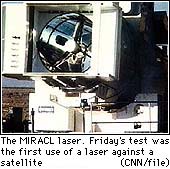Pentagon beams over military laser test

U.S. wants to determine vulnerability of satellites
October 20, 1997Web posted at: 5:50 p.m. EDT (2150 GMT)
WASHINGTON (CNN) -- In an effort to gauge the vulnerability of military satellites to laser attacks, the United States shot a ground-based Army laser at an aging Air Force satellite, the Pentagon announced Monday.
The announcement of Friday's laser test caused some political rock-throwing in and outside of Washington because of claims by some that the test is the first step in the militarization of space and a potential violation of treaties.
The Miniature Sensor Technology Integration (MSTI-3) satellite was "illuminated" by a high-powered, ground-based laser housed at the White Sands Missile Range in New Mexico shortly after dark on Friday evening.
Pentagon says test was success
Air Force Lt. Col. Robert Potter told CNN that the test was considered to be a success.
"It achieved the goal of the experiment, which was to determine the vulnerability of U.S. satellites," Potter said. As planned, "there was no permanent damage to the satellite or the (on-board) sensor," he said.
The Army's Mid-Infrared Advanced Chemical Laser (MIRACL), was fired at the satellite for only a brief time in an effort to collect data on the effects of laser beams on sensitive satellite equipment. The laser, built by TRW, is an offshoot of the Reagan administration's Strategic Defense Initiative, or "Star Wars" program.
Defense Secretary William Cohen on October 2 approved the plan to use MIRACL to illuminate the satellite. The test had been delayed several times by cloudy weather before Friday's shot.
The Army has test-fired lasers at missiles and other objects in test flights before, but it has never tested them against a satellite. The Russian government, which was informed of the test, has expressed concerns that the testing constitutes a potential threat to Russian satellites.
The Pentagon has repeatedly said the illumination would not violate any treaties and was not an attempt to build an anti-satellite weapon.
To justify the test, the U.S. points to the proliferation of powerful lasers around the world and their potential ability to wreak havoc on U.S. military satellites in times of crisis. The long-term goal is to find ways to shield the satellites from such an attack.
Satellite target being retired
MIRACL produces a beam of light six feet across using millions of watts from burning fuel. An extended beam of light from the laser would be capable of burning up a target.
The satellite was illuminated twice for the test. The first firing lasted for less than a second to simulate an accidental illumination. The second firing lasted for about 10 seconds at various power levels.
That longer illumination was designed to simulate an actual ground-based laser attack on a satellite and the effects on the satellite at various power levels. The MIRACL laser never went above 50 percent power during the course of the test, a military spokesman told CNN.
The MISTI satellite was selected as the target because it is scheduled to go into "eclipse phase" on Thursday and become useless thereafter. The satellite was originally designed to provide thermal sensing data for a global terrain mapping project.
Potter said test result data is still being collected.
Military Affairs Producer Chris Plante, The Associated Press and Reuters contributed to this report.